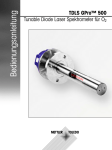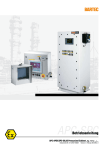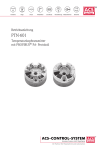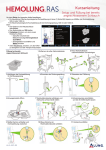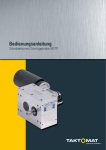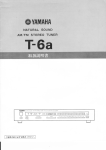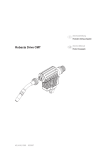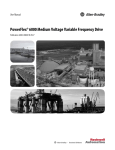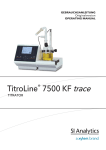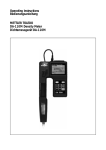Download Drying Oven Trocknungsofen Four de séchage DO307
Transcript
Operating Instructions Bedienungsanleitung Mode d‘emploi POWE R TEMPER ATURE °C HEATIN G 120 100 140 160 180 200 220 80 240 60 40 OFF 260 280 300 Drying Oven Trocknungsofen Four de séchage DO307 Français Deutsch English Contents Contents Page 1. Introduction ............................................................................................................... 3 2. Safety measures ........................................................................................................ 3 3. Overview ................................................................................................................... 5 4. Installation ................................................................................................................ 6 4.1 Installing the sample transport assembly .......................................................................6 4.2 4.2.1 4.2.2 4.2.3 Connecting the tubing ..................................................................................................7 Gas drying unit ........................................................................................................... 7 Gas outlet tubing “cold zone”: connection to the stop cock............................................... 8 Gas outlet tubing: connection to the titrator .................................................................... 8 5. Putting into operation ................................................................................................ 9 5.1 Purge gas flow ...........................................................................................................9 5.2 Baking out sample tube and glass boat .........................................................................9 5.3 5.3.1 5.3.2 Heating a sample to dryness ......................................................................................10 Introducing sample with the transport assembly ........................................................... 10 Introducing sample via the tapered joint ...................................................................... 11 5.4 Notes on the moisture determination ...........................................................................12 6. Options ................................................................................................................... 13 6.1 Air pump box ...........................................................................................................13 7. Error messages and malfunctions ............................................................................. 14 8. Maintenance ........................................................................................................... 15 8.1 Changing the fuses ...................................................................................................15 8.2 Cleaning the apparatus ..............................................................................................15 8.3 Cleaning the sample tube ..........................................................................................15 8.4 Replacing the sample tube .........................................................................................16 8.5 Changing the silica gel and molecular sieves ...............................................................16 METTLER TOLEDO DO307 1 Contents Contents Page 9. Standard and optional equipment ............................................................................. 17 9.1 Standard equipment ..................................................................................................17 9.2 Optional equipment ...................................................................................................19 10. Technical data ..........................................................................................................20 11. Heating temperatures for different substances ........................................................... 21 2 METTLER TOLEDO DO307 Introduction 1. Introduction The METTLER TOLEDO DO307 Drying Oven is used for moisture determination by the Karl Fischer method for samples where a direct moisture determination is not possible. Examples are insoluble samples or those whose determination yield false results due to side reactions with the KF reagent. The oven can also be an alternative to external extraction. The drying oven can be used together with both the volumetric and coulometric METTLER TOLEDO Karl Fischer titrators. The sample in a glass boat, or in an aluminium foil insert, is slid into a glass tube, where it is heated. This heating drives off any moisture from the sample in the form of vapor, which is then led from the glass tube to the KF titration cell by a stream of purge gas, such as dry air or nitrogen. In these operating instructions we explain the functions of the oven; we assume familiarity with the titrator used. 2. Safety measures The DO307 has been tested for the experiments and intended purposes documented in these Operating Instructions. However, this does not absolve you from the responsibility of performing your own tests of the product supplied by us regarding its suitability for the methods and purposes you intend to use it for. You should therefore observe the following safety measures. Measures for your protection – Never place or install objects on or above the apparatus ! These could catch fire. – Avoid heat buildup above the apparatus by leaving a free space of approx. 1 meter ! Readily flammable materials could ignite. – Never touch, during or after operation , the touch guard of the oven as well as the flange of the sample inlet, which is attached to the flange ring of the heating tube ! You could burn yourself. – Ensure that you plug the power cable supplied into a receptacle outlet that is grounded! In the absence of grounding, a technical fault could be lethal. – Switch the apparatus off and disconnect the power cable before you change blown fuses! An electric shock could be lethal. METTLER TOLEDO DO307 3 Safety measures – Never work in an environment subject to explosion hazards! The housing of the apparatus is not gas tight (explosion hazard due to spark formation, corrosion caused by the ingress of gases). – Never use reactive gases as a purge gas! They could lead to an explosion. – Check the gas paths and drying tubes for free gas flow ! This prevents buildup of an overpressure in the titration cell, which could lead to an explosion. – Open the stop cock before you stop the gas flow, switch off the apparatus or lower the temperature ! This prevents siphoning back of the titration solution into the hot drying oven. Failure to do this could result in an explosion hazard. – When using chemicals and solvents, comply with the instructions of the producer and the general lab safety rules! Measures for operational safety – Use only fuses of the type specified in the Operating Instructions ! – Have the apparatus opened and serviced only by METTLER TOLEDO service ! – Exclude the following environmental influences: • powerful vibrations, • direct sunlight, • atmospheric humidity greater than 75%, • temperatures below 5 °C and above 40 °C, • powerful electric or magnetic fields ! 4 METTLER TOLEDO DO307 Overview 3. Overview DO307 with connection to a titrator and to a pump Sample tube Touch guard Gas outlet tubing to titration cell Jacket tube Flanged ring of the sample inlet Screw cap POWE R TEMPER ATURE °C HEATIN G 120 100 Display of the actual temperature Heating control display: lit up until set temperature is reached, flashes at intervals when set temperature reached 180 200 240 40 On/off switch 140 160 220 80 60 OFF 260 280 300 Control unit Temperature setting Rear view Pump (optional) Drying unit Stop cock Touch guard Heating tube Knob to adjust orientation and height of the apparatus Cable of the oven control Type label Socket for connection of an air pump Power supply connection Fuse holder METTLER TOLEDO DO307 5 Installation 4. Installation 4.1 Installing the sample transport assembly This unit is used to insert the sample into the heated zone of the sample tube. – Place an aluminium insert into the glass boat. Aluminium insert – Insert the hook of the guide rod into the eye of the glass boat. Glass boat Guide rod Magnetic part – Fully slide back the slider towards the opening of the tube (as illustrated). Tapered joint – Carefully introduce the transport assembly into the sample tube until the position of the guide rod is fixed by the attraction of the slider. The boat is now positioned underneath the tapered joint. You can introduce samples through the tapered joint. Slider POWE R TEMP ERATU RE °C HEATI NG 120 140 – Insert a silicon stopper (septum) or NS stopper into the tapered joint. – Close the tube with the screw cap as shown. If you move the slider in towards the oven, the glass boat will be slid into the heating zone of the sample tube. 6 METTLER TOLEDO DO307 Installation 4.2 Connecting the tubing 4.2.1 Gas drying unit As the purge gas used must be 100% dry, we recommend to dry it before it flows into the oven using the gas drying unit (standard equipment). The drying agents silica gel and molecular sieves shown in the diagram are not part of the standard equipment; you must connect the connection tubing yourself. Connection tubing length 21 cm Tubing connection for gas inlet of the oven length 32 cm Connection tubing length 27 cm Male stud fittings Clamping ring 1st bottle: silica gel Gas supply to bottle base Bypass Connection to oven 2nd bottle: molecular sieve Flow meter Gas coupling – First fill the bottles: Fill the 1st bottle with silica gel whose capacity for water uptake is higher; fill the 2nd bottle with 3 Å molecular sieve to trap the remaining water. – Connect the flow meter to the 1st bottle with the 27 cm tubing: Press the ends into the quick fit connectors. In the case of the bottle; make sure to use the connection which leads the gas to the base of the bottle. – Connect the 1st bottle and the 2nd bottle with the 21 cm tubing: In the case of the 2nd bottle insert the tubing in the connection which leads the gas to the base of the bottle. – Connect the 2nd bottle and the gas inlet. – To loosen the tubing, press on the clamping rings with your fingertips and take out the tubing. – Connect the hose connector with barbed fitting to the gas source using tubing. – Set the gas flow rate (200 – 250 mL/min) on the flow meter. Hose connector with barbed fitting Quick acting coupler METTLER TOLEDO DO307 – To detach the hose connector, press the quick acting coupler in the direction of the arrow. 7 Installation – Connect the drying unit to the gas inlet of the sample tube. TEMPER ATURE °C 4.2.2 Gas outlet tubing “cold zone”: connection to the stop cock – Connect the stop cock with the gas outlet of the “cold zone”. 4.2.3 Gas outlet tubing: connection to the titrator Insulation Gas outlet Coupling – Screw the tubing nipple into the coupling in the direction shown so that the coupling is firmly seated. Tubing nipple 8 – Push the slot of the coupling of the insulated tubing over the gas outlet. – To remove the tubing, turn the nipple counterclockwise and pull off the coupling. METTLER TOLEDO DO307 Putting into operation 5. Putting into operation 5.1 Purge gas flow Gas flow with stop cock in open position. This allows purging of the “cold zone” of the sample tube (back purge). 5.2 Gas flow with stop cock in closed position. This allows purging of the “hot zone” of the sample tube (cell purge) for moisture transfer. Baking out sample tube and glass boat – Connect the apparatus to the power supply with the power cable. – Switch the instrument on: The temperature setting should be “Off” and the stop cock “open”. – Set the gas flow rate (200 – 250 mL/min) on the flow meter. – Purge the “cold zone” of the sample tube for approx. 5 minutes. Meanwhile prepare the titrator so that the drift can be measured. – Baking out the oven and the glass boat: • Close the stop cock to allow the purging of the “hot zone”. • Slide the boat to the end of the sample tube and set a temperature of 300 °C. The moisture in the sample tube is transferred to the titration cell. • Wait until the drift has dropped to below 50 µg/min (time required: approx. 15 minutes). The system is now free from moisture and ready for measurement. Notes 1. If the DO307 has been switched off for a relatively long time, you should always bake out the sample tube and glass boat before the first measurement. 2. If the DO307 is in daily use, we advise you not to shut off the purge gas, but simply reduce the flow rate to approx. 60 mL/min. 3. Open the stop cock before you stop the gas flow, switch off the apparatus or lower the temperature ! This prevents siphoning back of the titration solution into the hot drying oven. METTLER TOLEDO DO307 9 Putting into operation 5.3 Heating a sample to dryness 5.3.1 Introducing sample with the transport assembly – Set the oven temperature corresponding to the sample. Open the stop cock to allow purging of the “cold zone” of the sample tube during heating. – After the set temperature has been reached, close the stop cock to allow gas purge via the “hot zone” into the titration cell of the connected Karl Fischer titrator. Wait until a stable drift has been reached. – Place the aluminium insert into the glass boat and weigh the sample therein. – Open the stop cock to purge the “cold zone” of the sample tube and remove the screw cap. Stop cock closed – Insert the sample with the transport assembly into the sample tube, close the tube with the screw cap and purge the cold zone of the sample tube for approximately 2…3 minutes. – Close the stop cock to purge via the hot zone into the titration cell. – After a stable drift has been reached, start the titration at the titrator and slide the sample boat to the end of the sample tube. The moisture is then transferred into the titration cell. Stop cock open – After completion of the titration open the stop cock. Pull back the sample boat and allow it to cool before unscrewing the cap. – Remove the transport assembly and close the sample tube. Leave the stop cock open. “Cold zone” Sample Flanged ring 10 METTLER TOLEDO DO307 Putting into operation 5.3.2 Introducing sample via the tapered joint If you add your sample via the tapered joint, proceed as follows: – Open the stop cock to purge the “cold zone” of the sample tube. – Weigh the sample (syringe or weighing boat) and either inject it through the silicon stopper (septum) or take out the stopper and add the sample to a sample boat positioned below the inlet. – Close the stop cock to purge via the “hot zone” into the titration cell. – After a stable drift has been reached, start the titration at the titrator and slide the sample boat to the end of the sample tube. The moisture is then transferred into the titration cell. – After completion of the titration open the stop cock. Pull back the sample boat and allow it to cool before unscrewing the cap. – Remove the transport assembly and close the sample tube. Leave the stop cock open. Notes 1. You can heat several samples in the same aluminum insert to dryness if the sample residues do not have an adverse effect on the subsequent determinations. 2. The oven temperature should be as high as possible to liberate moisture quickly from the sample. However, decomposition, vaporization or sublimation of the sample should be avoided. Heating temperatures for several samples are listed in Section 11. METTLER TOLEDO DO307 11 Notes 5.4 Notes on the moisture determination 1. Enter the time required to liberate the moisture from the sample on the titrator as a stirring time to avoid premature termination of the titration (applies to volumetric titration). The liberation rate depends on the sample. 2. You should avoid a flow rate higher than 250 mL/min. If you do not, the moisture introduced as vapor would not be completely “trapped” by the titration solution, but would escape as gas from the titration cell. 3. The tubing which supplies the gas must be immersed in the titration solution by at least 4 mm ! Introduction of the “hot” vapor into the titration cell causes evaporation of the volatile fraction of the titration solution from the cell (within 8 hours up to 30 mL at an oven temperature of 200 °C and a gas flow rate of 200 mL/min). • With coulometric titrations, you should thus always top up the anolyte solution, with volumetric titrations with the particular solvent used. 4. For the DL32/DL39 Coulometer we advise replacing the straight drying tube of the generator electrode by a bent drying tube (see Section 9.2: Optional equipment). This prevents any solvent condensed on the drying tube from dripping into the catholyte. 12 METTLER TOLEDO DO307 Options 6. Options 6.1 Air pump box If you wish to use air for purging instead of an inert gas, you can attach an air pump box (see Section 9.2: Optional equipment) to the standard gas drying unit . – Switch off the DO307. – Connect the pump and the flow meter using the silicon tubing. – Connect the pump to the oven using the 8-pin cable supplied. – Switch on the DO307 and set the flow rate on the flow meter (200 – 250 mL/min). Switching on the oven also starts the air pump. Note Air contains oxygen which at elevated temperatures and above all with organic compounds, e.g. polymers and carbohydrates can lead to decomposition! METTLER TOLEDO DO307 13 Error messages 7. Error messages and malfunctions Coded error messages can appear on the temperature display; these and other malfunctions are listed in the following table: Error messages Cause Corrective action E1 Internal Pt1000 sensor faulty Call METTLER TOLEDO service E2 Board: Hardware fault Call METTLER TOLEDO service E3 Overtemperature protection has responded Switch apparatus off and then on again; if the error is again displayed, call METTLER TOLEDO service E4...En Call METTLER TOLEDO service Malfunctions Possible cause Corrective action No gas flow in titration cell at 200 mL/min Gas inlet/gas outlet connections not tight Check connections Screw cap not tight Tighten screw cap, check sealing Titration cell not tight Gas inlet/gas outlet connections not tight See Operating Instructions of the titrator Check connections Drying agent for purge gas exhausted Replace drying agent in gas drying unit No purge gas Check purge gas supply Discharge tip of the gas outlet tubing blocked Clean discharge tip with solvent No temperature display LED display or board faulty Check line voltage and fuses, replace if need be, otherwise call METTLER TOLEDO service Oven does not heat up Cable not plugged in Plug into cable socket Fuse blown Change fuses (see Section 8.1) Temperature set too low Set temperature higher Heating faulty Call METTLER TOLEDO service Titration finished too early Increase stirring time Temperature too low Set higher temperature Drift too high Moisture content found less than expected Subsequent consumption of titrant too high 14 METTLER TOLEDO DO307 Maintenance 8. Maintenance 8.1 Changing the fuses Switch off the DO307 and disconnect the power cable! – Loosen the fuse holder with 2 flat screwdrivers and take out. – Replace blown fuses with new ones with the same rating and push the fuse holder back in. 2 fuses: T2L250V Fuse holder 8.2 Cleaning the apparatus The housing of the oven is not splash proof. In case of contamination, it can be cleaned with a cloth moistened with alcohol. 8.3 Cleaning the sample tube You can clean the sample tube with chromic acid or other glass cleaning agents. – To dismantle it, see description in Section 8.4. – Dry the tube before installation and bake out following installation (see Section 5.2). METTLER TOLEDO DO307 15 Maintenance 8.4 Replacing the sample tube – Unscrew the screw cap and remove the sample transport assembly. Holder – Unscrew the holder and remove the spacing plate. Screw Sample tube Spacing plate – Carefully slide out the sample tube. – Slide the holder from the tube and remove it. Slider – Install the holder on the new sample tube. – Carefully slide the sample tube into the oven. – Screw on the spacing plate and the holder. Do not tighten the screws too tightly ! – Install the sample transport assembly. 8.5 Changing the silica gel and molecular sieves • You should change the silica gel of the gas drying unit as soon as it starts to turn pink. • You should change the molecular sieves when the drift value of the titration solution is two to three times higher than that with fresh molecular sieves. 16 METTLER TOLEDO DO307 Standard and optional equipment 9. Standard and optional equipment 9.1 Standard equipment Order No. 1 Drying oven DO307 POWER TEMPERAT URE °C HEATING 120 140 160 180 100 200 80 220 60 240 40 260 OFF 280 300 Operating Instructions Bedienungsanleitung Mode d‘emploi 1 Gas drying unit without tubing set (51108676) 51108660 1 Set of Operating Instructions in three languages English, German, French 51710092 POWE R TEMPERATURE °C HEATING 140 160 100120 180 200 220 80 240 60 40 OFF 260 280 300 DO307 Drying Oven Trocknungsofen DO307 Four de séchage DO307 1 Power cable 1 Phillips screwdriver METTLER TOLEDO DO307 in accordance with your order 73071 1 Tubing set with • length 210 mm • length 270 mm • 2 length 320 mm with coupling 51108676 1 Gas outlet tubing, insulated with coupling, length: 500 mm 51107355 1 Guide rod 51371101 17 Standard and optional equipment Order No. see optional equipment 2 Sample boats (glass) Aluminium insert Set of 50 1 Screw cap for sample tube Silicon stopper ST 14.5 (septum) 51191129 Set of 10 1 Three-hole adapter with plug stoppers for volumetric titrations 23276 23982 1 Stop cock incl. 2 screws 51191130 1 Adapter for DL32/DL39 51108761 Spare fuses T2L250V 18 51108649 Set of 3 13873 METTLER TOLEDO DO307 Standard and optional equipment 9.2 Optional equipment Order No. Sample boat (glass) 51108657 Sample tube 51371102 Male stud fitting with tail piece adapter Connection to gas source 51107375 Air pump box 51108670 1 kg Silica gel 250 g Molecular sieves 3 Å Drying tube bent for DL32/DL39 1 Tube silicon grease 105080 71478 51108639 71300 Silicon METTLER TOLEDO DO307 19 Technical data 10. Technical data Power supply connection • Voltage • Admissible voltage fluctuations • Frequency • Power consumption • Fuses 100…120 V / 200…240 V + 6 to – 10% 50/60 Hz 450 W T2L250V Temperature • Control range • Measurement deviation 40 °C…300 °C, steplessly adjustable 5 °C in the middle of the sample tube at 300 °C Interface • 8-pin mini DIN socket for air pump box Dimensions • Footprint housing • Space requirements • Sample tube • Effective boat volume • Weight 24 VDC unregulated, max. 10 W width 250 mm, depth 200 mm max. width 520 mm, height 390 mm, depth 220 mm diameter 30 mm, length 340 mm 15 cm3 5.5 kg Ambient conditions Ambient temperature : 5…40 °C Humidity 75% at 40 °C (non condensing) Use indoors Height up to 2000 m Overvoltage category II Pollution degree 2 Materials • Housing • Sample tube, heating tube, jacket tube • Flanged rings • Gas carrying tubing • Sample boat • Tubing connections 20 Sheet steel Borosilicate glass Aluminium Polyamide Borosilicate glass Stainless steel METTLER TOLEDO DO307 Heating temperatures 11. Heating temperatures for different substances Substance Heating temperature [°C] α-Polyoxymethylene (POM) ............................... ABS resin.......................................................... Calcium carbonate ............................................ Coal, carbon black ............................................ Copper sulfate ................................................... Epoxide resin .................................................... Ferrite ............................................................... Flour ................................................................ Iron oxide ......................................................... Manganese carbonate ........................................ Phenol resin ..................................................... Polyamide ........................................................ Polyacetal ........................................................ Polycarbonate (PC) ........................................... Polyethylene (PE) .............................................. Polyethylene terephthalate (PET) ......................... Polypropylene (PP) ........................................... Polystyrene (foamed) ........................................ Polystyrene (PS) ............................................... Polyvinyl alcohol (PVA) ..................................... Polyvinyl chloride (PVC) .................................... Rice flour .......................................................... Rubber ............................................................. Sodium nitrite .................................................... Sodium sulfite ................................................... Sodium tartrate * 2 H2O ..................................... Starch (grain, rice, soja) .................................... METTLER TOLEDO DO307 180 ......................... 160 ......................... 100 / 300 ................. 180 – 200 ................ 250 ......................... 230 ......................... 200 ......................... 150 ......................... 300 ......................... 300 ......................... 110 ......................... 140 – 200 ................ 200 ......................... 150 – 200 ................ 140 – 200 ................ 180 – 200 ................ 160 – 180 ................ 130 ......................... 150 ......................... 150 ......................... 130 – 160 ............... 150 ......................... 150 ......................... 150 ......................... 150 ......................... 200 ......................... 135 – 150 ................ Purge gas N2 N2 air or N2 N2 air or N2 N2 N2 N2 air or N2 air or N2 N2 N2 N2 N2 N2 N2 N2 N2 N2 N2 N2 N2 N2 N2 N2 N2 N2 21 Inhalt Inhaltsverzeichnis Seite 1. Einleitung .................................................................................................................. 3 2. Sicherheitsmassnahmen ............................................................................................ 3 3. Übersicht .................................................................................................................. 5 4. Installation ................................................................................................................ 6 4.1 Installation der Probentransporteinheit ...........................................................................6 4.2 4.2.1 4.2.2 4.2.3 Die Schläuche anschliessen .........................................................................................7 Gastrocknungseinheit .................................................................................................. 7 Gasauslass-Schlauch “kalte Zone”: Verbindung zum Absperrhahn .................................... 8 Gasauslass-Schlauch: Verbindung zum Titrator .............................................................. 8 5. Inbetriebnahme ......................................................................................................... 9 5.2 Spülgasfluss ..............................................................................................................9 5.2 Probenrohr und Glasschiffchen ausheizen .....................................................................9 5.3 5.3.1 5.3.2 Eine Probe ausheizen ................................................................................................10 Probe mit Probentransporteinheit einführen .................................................................. 10 Probe über den Schliffstutzen einführen ....................................................................... 11 5.4 Hinweise für die Wasserbestimmung ...........................................................................12 6. Optionen ................................................................................................................. 13 6.1 Luftpumpen-Box ...................................................................................................... 13 7. Fehlermeldungen und Störungen .............................................................................. 14 8. Wartung .................................................................................................................. 15 8.1 Die Sicherungen wechseln .........................................................................................15 8.2 Das Gerät reinigen ....................................................................................................15 8.3 Das Probenrohr reinigen ............................................................................................15 8.4 Das Probenrohr ersetzen ............................................................................................16 8.5 Silikagel und Molekularsieb wechseln .........................................................................16 METTLER TOLEDO DO307 1 Inhalt Inhaltsverzeichnis Seite 9. Zubehör .................................................................................................................. 17 9.1 Lieferumfang ............................................................................................................17 9.2 Fakultatives Zubehör .................................................................................................19 10. Technische Daten ..................................................................................................... 20 11. Heiztemperatur für verschiedene Sustanzen .............................................................. 21 2 METTLER TOLEDO DO307 Einleitung 1. Einleitung Der METTLER TOLEDO Trockenofen DO307 dient der Wasserbestimmung nach Karl Fischer von Proben, die für eine direkte Wasserbestimmung nicht geeignet ist. Beispiele sind unlösliche Proben oder solche, deren Bestimmung durch Nebenreaktionen mit dem KF-Reagenz falsche Resultate liefern. Der Ofen kann auch eine Alternative zur externen Extraktion sein. Der Trockenofen kann in Verbindung mit den volumetrischen und coulometrischen METTLER TOLEDO Karl-Fischer-Titratoren eingesetzt werden. Die Probe wird in einem Glasschiffchen oder in einem Aluminiumeinsatz in ein Glasrohr geschoben und dort erhitzt. Durch Erhitzen wird das in der Probe vorhandene Wasser als Dampf ausgetrieben und mit einem Spülgasstrom, z.B. getrocknete Luft oder Stickstoff, vom Glasrohr zur KF-Titrierzelle geleitet. In dieser Bedienungsanleitung erklären wir die Funktionen des Ofens, Kenntnis des eingesetzten Titrators setzen wir voraus. 2. Sicherheitsmassnahmen Der DO307 ist für die Versuche und Bestimmungen geprüft, die in dieser Bedienungsanleitung dokumentiert sind. Dies befreit Sie jedoch nicht von der eigenen Prüfung des von uns gelieferten Produktes auf seine Eignung für die von Ihnen beabsichtigten Verfahren und Zwecke. Befolgen Sie deshalb die folgenden Sicherheitsmassnahmen. Massnahmen zu Ihrem Schutz – Legen oder montieren Sie keine Gegenstände auf das bzw. über dem Gerät ! Diese können sich entzünden. – Vermeiden Sie einen Wärmestau über dem Gerät durch einen ca. 1 Meter hohen, freien Raum ! Leicht brennbare Materialien können sich entzünden. – Berühren Sie weder den Berührungsschutz noch den Befestigungsflansch der Probenzuführung während und nach dem Betrieb ! Sie können sich verbrennen. – Vergewissern Sie sich, dass Sie das mitgelieferte Netzkabel in eine Steckdose stecken, die geerdet ist ! Ein technischer Defekt könnte sonst lebensgefährlich sein. – Schalten Sie das Gerät ab und ziehen Sie das Netzkabel aus, bevor Sie defekte Sicherungen wechseln ! Ein elektrischer Schlag wäre lebensgefährlich. METTLER TOLEDO DO307 3 Sicherheitsmassnahmen – Arbeiten Sie nicht in explosionsgefährdeter Umgebung ! Das Gehäuse des Geräts ist nicht gasdicht (Explosionsgefahr durch Funkenbildung, Korrosion durch eindringende Gase). – Verwenden Sie keine reaktiven Gase als Spülgas ! Sie können zur Explosion führen. – Überprüfen Sie die Gaswege und Trockenrohre auf freien Gasfluss ! Die Bildung eines Überdrucks in der Titrierzelle, der zur Explosion führen kann, wird damit verhindert. – Öffnen Sie den Absperrhahn bevor Sie den Gaszufluss stoppen oder das Gerät ausschalten ! Die Titrierflüssigkeit kann dadurch nicht in den heissen Trockenofen zurückgesaugt werden. Eine Unterlassung kann zur Explosion führen. – Beachten Sie bei der Verwendung von Chemikalien und Lösemitteln die Vorschriften des Herstellers und die allgemeinen Sicherheitsregeln im Labor ! Massnahmen zur Betriebssicherheit – Verwenden Sie nur Sicherungen des in der Bedienungsanleitung spezifizierten Typs ! – Lassen Sie das Gerät nur vom METTLER TOLEDO Service öffnen und warten ! – Schliessen Sie folgende Umwelteinflüsse aus : • starke Vibrationen, • direkte Sonneneinstrahlung, • Luftfeuchtigkeit über 75%, • Temperaturen unter 5 °C und über 40 °C, • starke elektrische oder magnetische Felder ! 4 METTLER TOLEDO DO307 Übersicht 3. Übersicht DO307 mit Verbindung zu Titrator und Luftpumpe Probenrohr Berührungsschutz GasauslassSchlauch zur Titrierzelle Mantelrohr Flansch der Probenzuführung Schraubdeckel POWE R TEMPER ATURE °C HEATIN G 120 100 Anzeige der Ist-Temperatur Heizkontrollanzeige: leuchtet stetig bis Soll-Temperatur erreicht ist blinkt in Zeitabständen, wenn Soll-Temperatur erreicht ist 180 200 240 40 Ein/Aus Schalter 140 160 220 80 60 OFF 260 280 300 Steuergerät Temperatureinstellung Pumpe (optional) Trockeneinheit Rückansicht Absperrhahn Berührungsschutz Heizrohr Knopf, um Richtung und Höhe des Ofens zu verstellen Kabel der Ofensteuerung Typenschild Buchse für Anschluss einer Luftpumpe Netzanschluss Sicherungshalter METTLER TOLEDO DO307 5 Installation 4. Installation 4.1 Installation der Probentransporteinheit Diese Einheit wird zum Einführen der Probe in den beheizten Teil des Probenrohrs verwendet. – Aluminiumeinsatz in ein Glasschiffchen legen. Aluminiumeinsatz – Den Haken der Schubstange in die Öse des Glasschiffchens einführen. Glasschiffchen Schubstange Magnetteil – Den Schieber ganz zurück ziehen in Richtung der Öffnung des Probenrohrs. Schliffstutzen – Die Probentransporteinheit vorsichtig in das Probenrohr einführen, bis die Schubstange durch die magnetische Anziehung des Schiebers fixiert wird. Das Schiffchen ist unterhalb des Schliffstutzens positioniert. Durch den Schliffstutzen können nun Proben zugegeben werden. Schieber POWE R TEMP ERATU RE °C HEATI NG 120 140 – Einen Silikonstopfen (Septum) oder NS Stopfen auf den Schliffstutzen setzen. Wird der Schieber Richtung Ofen bewegt, so wird das Schiffchen in den beheizten Teil des Probenrohrs gebracht. 6 METTLER TOLEDO DO307 Installation 4.2 Die Schläuche anschliessen 4.2.1 Gastrocknungseinheit Da das verwendete Spülgas 100%ig trocken sein sollte, empfehlen wir, es mit der Gastrocknungseinheit (Lieferumfang) zu trocknen, bevor es in den Ofen einströmt. Die in der Abbildung gekennzeichneten Trocknungsmittel Silikagel und Molekularsieb gehören nicht zum Lieferumfang; die Verbindungsschläuche müssen Sie selbst anschliessen. Verbindungsschlauch 21 cm lang Schlauchverbindung zum Gaseinlass des Ofens Länge 32 cm Verbindungsschlauch 27 cm lang Einschraubanschlüsse Klemmring 1. Flasche: Silikagel Gasführung bis zum Flaschen-boden Bypass Anschluss zum Ofen 2. Flasche: Molekularsieb Durchflussmesser Gaskupplung – Zuerst die Flaschen füllen: Die 1. Flasche mit Silikagel, dessen Kapazität für die Wasseraufnahme höher ist; die 2. Flasche mit Molekularsieb 3 Å, das die restliche Feuchtigkeit aufnimmt. – Den Durchflussmesser und 1. Flasche mit dem 27 cm langen Schlauch verbinden: Die Enden in die Einschraubanschlüsse drücken; bei der Flasche in den Anschluss, der das Gas bis zum Flaschenboden führt. – Die 1. und 2. Flasche mit dem 21 cm langen Schlauch verbinden: Bei der 2. Flasche den Schlauch in den Anschluss stecken, der das Gas bis zum Flaschenboden führt. – Die 2. Flasche und den Gaseinlass verbinden. – Um die Schläuche wieder zu lösen, mit den Fingerspitzen auf die Klemmringe drücken und die Schläuche herausziehen. – Die Stecktülle durch einen Schlauch mit der Gasquelle verbinden. – Am Durchflussmesser den Gasdurchfluss einstellen (200 – 250 mL/min). Stecktülle – Um die Stecktülle zu lösen, die Schnellkupplung in Pfeilrichtung drücken. Schnellkupplung METTLER TOLEDO DO307 7 Installation – Die Gastrocknungseinheit mit dem Gaseinlass des Probenrohrs verbinden. TEMPER ATURE °C 4.2.2 Gasauslass-Schlauch “kalte Zone” : Verbindung zum Absperrhahn – Absperrhahn mit dem Gasauslass “kalte Zone” verbinden. 4.2.3 Gasauslass-Schlauch : Verbindung zum Titrator – Die Kerbe der Kupplung des isolierten Schlauches über den Gasauslass schieben. Isolation Gasauslass Kupplung Schlauchnippel 8 – Den Schlauchnippel in der angezeigten Richtung in die Kupplung einschrauben, so dass diese festsitzt. – Um den Schlauch abzunehmen, den Nippel in Gegenrichtung aufdrehen und die Kupplung abziehen. – Das andere Schlauchende in den Stopfen des entsprechenden Titrators stecken (siehe Kap. 9.1: Lieferumfang). METTLER TOLEDO DO307 Inbetriebnahme 5. Inbetriebnahme 5.2 Spülgasfluss Gasfluss mit geöffnetem Absperrhahn. Dies ermöglicht die Spülung der “kalten Zone” des Probenrohrs (Rückspülung). 5.2 Gasfluss mit geschlossenem Absperrhahn. Dies ermöglicht die Spülung der “heissen Zone” des Probenrohrs (Zellenspülung) für den Gasfluss zur Titrierzelle. Probenrohr und Glasschiffchen ausheizen – Das Gerät durch das Netzkabel mit dem Netz verbinden. – Das Gerät einschalten, wobei die Temperatureinstellung auf “Off” stehen und der Absperrhahn geöffnet sein sollte. – Den Gasdurchfluss am Durchflussmesser auf 200 – 250 mL/min einstellen. – Die “kalte Zone” des Probenrohrs etwa 5 Minuten spülen. Gleichzeitig Titrator vorbereiten, so dass die Drift gemessen werden kann. – Den Ofen und das Glasschiffchen ausheizen: • Absperrhahn schliessen. Dies ermöglicht die Spülung der “heissen Zone” des Probenrohrs. • Das Schiffchen an das Probenrohrende schieben und eine Temperatur von 300 °C einstellen. Die Feuchtigkeit wird in die Titrierzelle transportiert. • Warten, bis die Drift unter 50 µg/min gefallen ist (Dauer: ca. 15 Minuten). Das System gilt jetzt als “wasserfrei” und messbereit. Hinweise 1. Wenn der DO307 für längere Zeit abgeschaltet war, sollten Sie Probenrohr und Glasschiffchen jeweils vor der ersten Messung wieder ausheizen. 2. Wenn Sie den DO307 täglich einsetzen, empfehlen wir, das Spülgas nicht abzustellen, sondern den Durchfluss auf ca. 60 mL/min herabzusetzen. 3. Öffnen Sie den Absperrhahn bevor Sie den Gaszufluss stoppen oder das Gerät ausschalten ! Die Titrierflüssigkeit kann dadurch nicht in den heissen Trockenofen zurückgesaugt werden. METTLER TOLEDO DO307 9 Inbetriebnahme 5.3 Eine Probe ausheizen 5.3.1 Probe mit Probentransporteinheit einführen – Die Ofentemperatur der Probe entsprechend einstellen. – Wenn die eingestellte Temperatur erreicht ist, den Absperrhahn schliessen so dass der Gasfluss über die “heisse Zone” des Probenrohrs in die Karl-Fischer Titrierzelle erfolgt. Warten bis die Drift einen stabilen Wert erreicht hat. – Aluminiumeinsatz in ein Glasschiffchen legen und die Probe einwägen. – Den Absperrhahn öffnen um die “kalte Zone” des Probenrohrs zu spülen. Den Schraubdeckel entfernen. Absperrhahn zu – Die Probentransporteinheit in das Probenrohr einführen, Das Probenrohr mit dem Schraubdeckel schliessen und die “kalte Zone” für etwa 2…3 Minuten spülen. – Absperrhahn schliessen so dass der Gasfluss über die “heisse Zone” des Probenrohrs in die Karl-Fischer Titrierzelle erfolgt. – Wenn eine stabile Drift erreicht ist die Titration im Titrator starten und das Schiffchen an das Ende des Probenrohrs schieben. Die Feuchtigkeit wird in die Titrierzelle überführt. Absperrhahn offen – Wenn der Endpunkt der Titration erreicht ist den Absperrhahn öffnen. Das Schiffchen zurückziehen und abkühlen lassen, bevor der Schraubdeckel abgeschraubt wird. – Probentransporteinheit entfernen und Probenrohr wieder verschliessen. Den Absperrhahn geöffnet lassen. “Kalte Zone” Probe Flanschring 10 METTLER TOLEDO DO307 Inbetriebnahme 5.3.2 Probe über den Schliffstutzen einführen Wenn die Probe über den Stutzen zugegeben werden soll, wird folgendermassen vorgegangen: – Den Absperrhahn öffnen um die “kalte Zone” des Probenrohrs zu spülen. – Probe wiegen (Spritze oder Wägeschiffchen) und entweder durch den Silikonstopfen (Septum) einspritzen oder den Stopfen abnehmen und die Probe zugeben. – Den Absperrhahn schliessen, so dass der Gasfluss über die “heisse Zone” des Probenrohrs in die Karl-Fischer Titrierzelle erfolgt. – Wenn eine stabile Drift erreicht ist, die Titration am Titrator starten und das Schiffchen an das Ende des Probenrohrs schieben. Die Feuchtigkeit wird in die Titrierzelle transportiert. – Wenn der Endpunkt der Titration erreicht ist, den Absperrhahn öffnen. Das Schiffchen zurückziehen und abkühlen lassen, bevor der Schraubdeckel abgeschraubt wird. – Probentransporteinheit entfernen und Probenrohr wieder verschliessen. Den Absperrhahn geöffnet lassen. Hinweise 1. Sie können mehrere Proben im gleichen Aluminiumeinsatz ausheizen, falls Probenrückstände nachfolgende Bestimmungen nicht beeinträchtigen. 2. Die Ofentemperatur sollte möglichst hoch sein, um das Wasser aus der Probe schnell freizusetzen. Zersetzung, Verdampfung oder Sublimation der Probe sind jedoch zu vermeiden. Ausheiztemperaturen für einige Substanzen sind in Kap. 11 aufgeführt. METTLER TOLEDO DO307 11 Hinweise 5.4 Hinweise für die Wasserbestimmung 1. Die zur Freisetzung des Wassers aus der Probe benötigte Zeit geben Sie am Titrator als Rührzeit ein, um einen verfrühten Titrationsabbruch zu vermeiden (gilt für die volumetrische Titration). Die Freisetzungsgeschwindigkeit hängt von der Probe ab. 2. Einen höheren Durchfluss als 250 mL/min sollten Sie vermeiden. Dadurch würde das als Dampf eingeführte Wasser nicht vollständig von der Titrierlösung “aufgefangen”, sondern würde als Gas aus der Zelle entweichen. 3. Der das Gas einführende Schlauch muss mindestens 4 mm in die Titrierlösung eintauchen! Durch die Überleitung des “heissen” Dampfes in die Titrierzelle verdampft der leichtflüchtige Anteil der Titrierlösung aus der Titrierzelle (innerhalb von 8 Stunden bis zu 30 mL bei einer Ofentemperatur von 200 °C und einem Gasdurchfluss von 200 mL/min). • Bei coulometrischen Titrationen sollten Sie deshalb jeweils die Anolytlösung nachfüllen, bei volumetrischen Titrationen das eingesetzte Lösemittel. 4. Für das Coulometer DL32/DL39 empfehlen wir, das Trockenrohr der Generatorelektrode durch ein gekrümmtes Trocknungsrohr zu ersetzen (siehe Kap. 9.2: Fakultatives Zubehör). Dadurch kann am Trockenrohr kondensierendes Lösemittel nicht in den Katholyten tropfen. 12 METTLER TOLEDO DO307 Optionen 6. Optionen 6.1 Luftpumpen-Box Wenn Sie Luft anstatt Inertgas zur Spülung einsetzen wollen, können Sie eine Luftpumpen-Box an die Gastrocknungseinheit anschliessen (siehe Kap. 9.2: Fakultatives Zubehör). – Den DO307 ausschalten. – Pumpe und Durchflussmesser mit dem Silikonschlauch verbinden. – Pumpe und Ofen mit dem 8-Pin Kabel verbinden. – Den DO307 einschalten und am Durchflussmesser den Gasdurchfluss einstellen (200 – 250 mL/min). Mit dem Einschalten des Ofens läuft auch die Luftpumpe. Die Luft wird über die Schläuche in den Ofen gepumpt. Achtung Luft enthält Sauerstoff, der bei höheren Temperaturen vor allem bei organischen Substanzen, z.B. Polymeren zur Zersetzung führen kann ! METTLER TOLEDO DO307 13 Fehlermeldungen 7. Fehlermeldungen und Störungen Auf der Temperaturanzeige können codierte Fehlermeldungen erscheinen; diese und sonstige Störungen sind in der folgenden Tabelle aufgeführt: Fehlermeldungen Ursache Abhilfe E1 Interner Pt1000-Fühler defekt METTLER TOLEDO-Service anfragen E2 Print: Hardware-Fehler METTLER TOLEDO-Service anfragen E3 Übertemperaturschutz hat angesprochen Gerät aus- und wieder einschalten; wenn der Fehler danach wieder angezeigt wird, METTLER TOLEDO-Service anfragen E4...En METTLER TOLEDO-Service anfragen Störungen Mögliche Ursache Abhilfe Kein Gasfluss in Titrierzelle bei 200 mL/min Gasein/GasauslassAnschlüsse undicht Anschlüsse prüfen Schraubdeckel nicht dicht Schraubdeckel anziehen, Dichtung überprüfen Titrierzelle undicht Gasein/GasauslassAnschlüsse undicht Siehe Bedienungsanleitung des Titrators Anschlüsse prüfen Trocknungsmittel für Spülgas verbraucht Trocknungsmittel in Gastrocknungseinheit erneuern Spülgas fehlt Spülgasversorgung prüfen Ausströmspitze des Gasauslass-Schlauchs verstopft Ausströmspitze mit Lösemittel reinigen Keine TemperaturAnzeige LED-Anzeige oder Print defekt Netzspannung und Sicherungen kontrollieren und eventuell ersetzen, sonst METTLER TOLEDO-Service anfragen Ofen heizt nicht Kabel nicht eingesteckt Kabelbuchse einstecken Sicherung defekt Sicherungen wechseln (siehe Kap. 8.1) Temperatur zu tief eingestellt Temperatur höher einstellen Heizung defekt METTLER TOLEDO-Service anfragen Titration zu früh beendet Rührzeit verlängern Temperatur zu tief Höhere Temperatur einstellen Drift zu hoch Gefundener Wassergehalt tiefer als erwartet Nachverbrauch des Titriermittels zu hoch 14 METTLER TOLEDO DO307 Wartung 8. Wartung 8.1 Die Sicherungen wechseln Den DO307 ausschalten und das Netzkabel herausziehen! – Den Sicherungshalter mit 2 flachen Schraubenziehern lösen und herausziehen. – Die defekten Sicherungen mit neuen des gleichen Typs ersetzen und den Sicherungshalter wieder einschieben. 2 Sicherungen: T2L250V Sicherungshalter 8.2 Das Gerät reinigen Das Gehäuse des Ofens ist nicht spritzwasserdicht. Bei Verschmutzung können Sie es mit einem alkoholfeuchten Lappen reinigen. 8.3 Das Probenrohr reinigen Das Probenrohr können Sie mit Chromschwefelsäure oder anderen Glasreinigungsmitteln reinigen. – Um es zu demontieren, siehe die Beschreibung in Kap 8.4. – Das Rohr vor der Installation trocknen und nach der Installation ausheizen (siehe Kap. 5.2). METTLER TOLEDO DO307 15 Wartung 8.4 Das Probenrohr ersetzen – Schraubdeckel abschrauben und die Transporteinheit entfernen. Halter – Halter abschrauben und Metallplättchen entfernen. Schrauben Probenrohr Metallplättchen – Das Probenrohr vorsichtig herausziehen. – Den Halter über das Rohr schieben und entfernen. Schieber – Den Halter auf das neue Rohr schieben. – Vorsichtig das neue Rohr in den Ofen einführen. – Halter und Metallplättchen festschrauben. Schrauben nicht zu stark anziehen ! – Die Probentransporteinheit in das Probenrohr einsetzen. 8.5 Silikagel und Molekularsieb wechseln • Das Silikagel der Gastrocknungseinheit sollten Sie wechseln, sobald es sich rosa färbt. • Das Molekularsieb sollten Sie wechseln, wenn der Driftwert der Titrierlösung zwei- bis dreimal höher ist als mit frischem Molekularsieb. 16 METTLER TOLEDO DO307 Zubehör 9. Zubehör 9.1 Lieferumfang 1 Trockenofen Bestell-Nr. DO307 POWER TEMPERAT URE °C HEATING 120 140 160 180 100 200 80 220 60 240 40 260 OFF 280 300 Operating Instructions Bedienungsanleitung Mode d‘emploi 1 Gastrocknungseinheit ohne Schlauchset (51108676) 51108660 1 Bedienungsanleitung dreisprachig deutsch, englisch, französisch 51710092 POWE R TEMPERATURE °C HEATING 140 160 100120 180 200 220 80 240 60 40 OFF 260 280 300 DO307 Drying Oven Trocknungsofen DO307 Four de séchage DO307 1 Netzkabel 1 Kreuzschlitz-Schraubenzieher METTLER TOLEDO DO307 gemäss Ihrer Bestellung 73071 1 Schlauchset • Länge 210 mm • Länge 270 mm • 2 Länge 320 mm mit Kupplungen 51108676 1 Gasauslass-Schlauch isoliert mit Kupplung, Länge: 500 mm 51107355 1 Schubstange 51371101 17 Zubehör Bestell-Nr. siehe fakultatives Zubehör 2 Glasschiffchen Aluminiumeinsatz Set à 50 Stück 1 Schraubdeckel für Probenrohr Silikonstopfen: NS 14,5 (Septum) 51191129 Set à 10 Stück 1 Dreiloch-Adapter mit Verschluss-Stopfen für volumetrische Titrationen 23276 23982 1 Absperrhahn 51191130 1 Gaseinlass-Stopfen für DL32/DL39 51108761 Ersatz-Sicherungen T2L250V 18 51108649 Set a 3 Stück 13873 METTLER TOLEDO DO307 Zubehör 9.2 Fakultatives Zubehör Glasschiffchen Bestell-Nr. 51108657 Probenrohr 51371102 Einschraubanschluss mit Schraubtülle Anschluss an Gasquelle 51107375 Luftpumpen-Box 51108670 1 kg Silikagel 250 g Molekularsieb 3 Å Trocknungsrohr gekrümmt für DL32/DL39 1 Tube Silikonfett 105080 71478 51108639 71300 Silicon METTLER TOLEDO DO307 19 Technische Daten 10. Technische Daten Netzanschluss • Spannung • Zulässige Spannungsschwankungen • Frequenz • Leistungsaufnahme • Sicherungen 100…120 V / 200…240 V +6 bis –10% 50/60 Hz 450 W T2L250V Temperatur • Regelbereich • Messabweichung 40 °C…300 °C, stufenlos einstellbar 5 °C in der Mitte des Probenrohrs bei 300 °C Schnittstelle • 8 pol Mini-Din-Buchse für Luftpumpen-Box Abmessungen • Standfläche Gehäuse • Raumbedarf • Probenrohr • Nutzbares Schiffchenvolumen • Gewicht Umgebungsbedingungen Materialien • Gehäuse • Probenrohr, Heizrohr, Mantelrohr • Flanschringe • Gasführende Schläuche • Glasschiffchen • Schlauchtüllen 20 24 VDC ungeregelt, max. 10 W 250 mm breit, 200 mm tief max. 520 mm breit, 390 mm hoch, 220 mm tief 30 mm Durchmesser, 340 mm lang 15 cm3 5,5 kg Umgebungstemperatur: 5…40 °C Feuchtigkeit 75% bei 40 °C (nicht kondensierend) Verwendung in Innenräumen Höhe bis 2000 m Überspannungskategorie II Verschmutzungsgrad 2 Stahlblech Borosilikat-Glas Aluminium Polyamid Borosilikat-Glas Rostfreier Stahl METTLER TOLEDO DO307 Heiztemperaturen 11. Heiztemperatur für verschiedene Sustanzen Substanz Heiztemperatur [°C] a-Polyoxymethylen (POM) ................................. ABS-Harz.......................................................... Calciumcarbonat ............................................... Eisenoxid ......................................................... Epoxidharz ....................................................... Ferrit ................................................................ Gummi ............................................................. Kohle, Russ ...................................................... Kupfersulfat ...................................................... Mangancarbonat ............................................... Mehl ................................................................ Natriumnitrit ...................................................... Natriumsulfit ..................................................... di-Natriumtartrat * 2 H2O ................................... Phenolharz ....................................................... Polyamid.......................................................... Polyacetal ........................................................ Polycarbonat (PC) ............................................. Polyethylen (PE) ............................................... Polyethylenterephthalat (PET) ............................. Polypropylen (PP) ............................................. Polystyrol (geschäumt) ...................................... Polystyrol (PS) .................................................. Polyvinylalkohol (PVA) ...................................... Polyvinylchlorid (PVC) ....................................... Reismehl .......................................................... Stärke (Getreide, Reis, Soja) ............................... METTLER TOLEDO DO307 180 ......................... 160 ......................... 100 / 300 ................. 300 ......................... 230 ......................... 200 ......................... 150 ......................... 180 – 200 ................ 250 ......................... 300 ......................... 150 ......................... 150 ......................... 150 ......................... 200 ......................... 110 ......................... 140 – 200 ................ 200 ......................... 150 – 200 ................ 140 – 200 ................ 180 – 200 ................ 160 – 180 ................ 130 ......................... 150 ......................... 150 ......................... 130 – 160 ................ 150 ......................... 135 – 150 ................ Spülgas N2 N2 Luft oder N2 Luft oder N2 N2 N2 N2 N2 Luft oder N2 Luft oder N2 N2 N2 N2 N2 N2 N2 N2 N2 N2 N2 N2 N2 N2 N2 N2 N2 N2 21 Sommaire Sommaire Page 1. Introduction ............................................................................................................... 3 2. Mesures de sécurité .................................................................................................. 3 3. Vue d'ensemble ......................................................................................................... 5 4. Installation ................................................................................................................ 6 4.1 Installation de l'unité de transport de l'échantillon ...........................................................6 4.2 4.2.1 4.2.2 4.2.3 Branchement des tuyaux .............................................................................................7 Unité de dessiccation .................................................................................................. 7 Tuyau de sortie de gaz “zone froide”: raccordement à la vanne d'arrêt .............................. 8 Tuyau de sortie de gaz: raccordement au titrateur ........................................................... 8 5. Mise en service ......................................................................................................... 9 5.2 Flux du gaz de balayage .............................................................................................9 5.2 Chauffage du tube porte-échantillon et de la nacelle en verre............................................9 5.3 5.3.1 5.3.2 Chauffage d'un échantillon .........................................................................................10 Introduction de l'échantillon à l'aide de l'unité de transport............................................. 10 Introduction de l'échantillon par le manchon rodé ......................................................... 11 5.4 Remarques sur la détermination de la teneur en eau .....................................................12 6. Options ................................................................................................................... 13 6.1 Pompe à air .............................................................................................................13 7. Messages d'erreur et dysfonctionnements ................................................................. 14 8. Maintenance ........................................................................................................... 15 8.1 Remplacement des fusibles ........................................................................................15 8.2 Nettoyage de l'appareil ..............................................................................................15 8.3 Nettoyage du tube porte-échantillon ............................................................................15 8.4 Remplacement du tube porte-échantillon .....................................................................16 8.5 Remplacement du silicagel et du tamis moléculaire ......................................................16 METTLER TOLEDO DO307 1 Sommaire Sommaire Page 9. Accessoires ............................................................................................................. 17 9.1 Equipement standard ................................................................................................17 9.2 Accessoires facultatifs ...............................................................................................19 10. Caractéristiques techniques ..................................................................................... 20 11. Température de chauffage de diverses substances ..................................................... 21 2 METTLER TOLEDO DO307 Introduction 1. Introduction Le four de séchage METTLER TOLEDO DO307 permet de déterminer la teneur en eau des échantillons selon la méthode Karl Fischer. Il est utilisé dans les cas où une mesure directe est impossible, par exemple, pour les échantillons non solubles ou pour les échantillons dont les résultats sont faussés par des réactions secondaires avec le réactif KF. Le four peut également constituer une solution de remplacement pour l'extraction externe. Le four de séchage peut être utilisé conjointement avec les titrateurs Karl-Fischer volumétriques et coulométriques de METTLER TOLEDO. L'échantillon, placé dans une nacelle en verre ou dans un creuset métallique, est introduit dans un tube en verre, où il est chauffé. L'eau de l'échantillon, dégagée sous forme de vapeur, est alors entraînée par un gaz de balayage, par exemple de l'air sec ou de l'azote, du tube de verre vers la cellule de titrage KF. Ce mode d'emploi décrit les fonctions du four. L'usage du titrateur utilisé est supposé connu. 2. Mesures de sécurité Le DO307 a été contrôlé en vue des essais et usages prévus, décrits dans ce mode d’emploi. Ceci ne décharge cependant pas l'utilisateur de s'assurer que le produit livré est approprié aux procédés et objectifs envisagés. En conséquence, respecter les consignes de sécurité suivantes : Pour la sécurité de l'utilisateur – Ne rien poser sur l'appareil, ne rien installer au-dessus ! Les objets pourraient s'enflammer. – Laisser un espace de 1 mètre environ au-dessus de l'appareil pour éviter tout accumulation de chaleur ! Les matériaux facilement inflammables pourraient brûler. – Ne pas toucher la grille de protection ni la bride de fixation du tube porte-échantillon pendant et après le fonctionnement de l'appareil ! Risque de brûlure. – S'assurer que le câble d'alimentation fourni avec l'appareil est enfiché dans une prise reliée à la terre ! Un défaut technique pourrait provoquer des accidents mortels. – Mettre l'appareil hors tension et retirer le câble d'alimentation avant de changer un fusible défectueux ! Risque d'électrocution. METTLER TOLEDO DO307 3 Mesures de sécurité – Ne pas travailler pas dans une atmosphère explosible ! Le boîtier de l’appareil n’est pas étanche aux gaz (risque d’explosion par étincelles, de corrosion par pénétration de gaz). – Ne pas utiliser pas de gaz de balayage réactif ! Il pourrait provoquer une explosion. – Vérifier la libre circulation du gaz dans les conduites et dans les cartouches de dessicatif ! Ceci permet d'éviter une éventuelle surpression dans la cellule de titrage, ce qui pourrait engendrer une explosion. – Ouvrir la vanne d'arrêt avant d'arrêter l'arrivée de gaz ou avant de mettre l'appareil hors tension ! La solution de titrage ne pourra ainsi pas être aspirée dans le four de séchage chaud. Une négligence pourrait entraîner une explosion. – Respecter lors de l'emploi de produits chimiques et de solvants les instructions du fabricant ainsi que les consignes générales de sécurité en laboratoire ! Pour la sécurité de fonctionnement – N'utiliser que des fusibles du modèle spécifié dans le mode d'emploi ! – Confier la maintenance de l’appareil exclusivement au service après-vente METTLER TOLEDO ! – Eviter les conditions environnantes suivantes : • vibrations importantes, • exposition au soleil, • taux d’humidité supérieur à 75%, • températures inférieures à 5 °C et supérieures à 40 °C, • champs électriques et magnétiques importants ! 4 METTLER TOLEDO DO307 Vue d'ensemble 3. Vue d'ensemble Raccordement du DO307 au titrateur et à la pompe à air tube porte-échantillon grille de protection tuyau de sortie du gaz vers la cellule de titrage tube enveloppe bride d'entrée de l'échanitllon bouchon vissé POWE R TEMPER ATURE °C HEATIN G 120 100 180 200 240 40 interrupteur principal 140 160 220 80 60 OFF 260 280 300 affichage de la température effective voyant de contrôle du chauffage: allumé jusqu'à ce que la température de consigne soit atteinte, clignotant lorsque la température de consigne est atteinte unité de commande réglage de la température pompe (en option) unité de dessiccation Vue de l'arrière vanne d'arrêt grille de protection tube chauffant bouton de réglage de la hauteur et de l'orientation du four câble de commande du four plaque signalétique raccord pour pompe à air connecteur pour câble d'alimentation porte-fusible METTLER TOLEDO DO307 5 Installation 4. Installation 4.1 Installation de l'unité de transport de l'échantillon Cette unité est employée pour l'introduction de l'échantillon dans la partie chauffée du tube porteéchantillon. – Poser le creuset en aluminium dans une nacelle en verre. creuset en aluminium – Introduire l'extrémité courbée de la tige dans l'oeillet de la nacelle en verre. nacelle en verre tige partie magnétique – Tirer complètement le coulisseau dans le sens de l'ouverture du tube porte-échantillon. – Insérer avec précaution l'unité de transport d'échantillon dans le tube porte-échantillon jusqu'à ce que la tige soit fixée par l'attraction magnétique du coulisseau. La nacelle se trouve sous le manchon rodé par lequel l'échantillon peut être introduit. manchon rodé coulisseau POWE R TEMP ERATU RE °C HEATI NG 120 140 – Fermer le manchon par un bouchon en silicone (septum) ou un bouchon à rodage normalisé. Pousser le coulisseau vers le four pour amener la nacelle dans la partie chauffée du tube porteéchantillon. 6 METTLER TOLEDO DO307 Installation 4.2 Branchement des tuyaux 4.2.1 Unité de dessiccation Le gaz de balayage doit être absolument sec. Nous recommandons par conséquent de le sécher dans l'unité de dessiccation (fournie avec l'appareil) avant qu'il ne pénètre dans le four. Les dessiccateurs indiqués sur la figure, le silicagel et le tamis moléculaire, ne sont pas compris dans la livraison; les tuyaux de raccordement doivent être raccordés par l'utilisateur. tuyau de 21 cm tuyau de raccordement à l'arrivée de gaz du four longueur 32 cm tuyau de 27 cm raccords à vis bague de blocage flacon 1: silicagel arrivée du gaz au fond du flacon bypass raccord relié au four flacon 2: tamis moléculaire débitmètre raccord rapide – Remplir tout d'abord les flacons : le premier de silicagel, dont la capacité d'absorption est plus importante, le deuxième de tamis moléculaire 3 Å pour l'absorption de l'humidité résiduelle. – Relier le débitmètre et le 1er flacon avec le tuyau de 27 cm : enfoncer les extrémités dans les raccords filetés. Au niveau de la bouteille, utiliser le raccord qui amène le gaz au fond du flacon. – Relier les flacons 1 et 2 avec le tuyau de 21 cm : introduire le tuyau dans le raccord du flacon 2 qui amène le gaz au fond du flacon. – Relier le flacon 2 à l'arrivée de gaz. – Pour retirer les tuyaux, appuyer avec les doigts sur la bague de blocage puis tirer. – Raccorder par un tuyau l'embout du raccord rapide à la source de gaz. – Régler le débit sur le débitmètre (200 – 250 mL/min). – Pour retirer le tuyau, pousser le raccord rapide dans le sens de la flèche. embout cannelé raccord rapide METTLER TOLEDO DO307 7 Installation – Raccorder l'unité de dessiccation à l'arrivée de gaz du tube porte-échantillon. TEMPER ATURE °C 4.2.2 Tuyau de sortie de gaz “zone froide” : raccordement à la vanne d'arrêt – Raccorder la vanne d'arrêt à la sortie de gaz “zone froide”. 4.2.3 Tuyau de sortie de gaz : raccordement au titrateur – Glisser l'encoche du raccord du tuyau isolé sur la sortie de gaz. Isolation sortie de gaz raccord – Visser dans le sens indiqué l'embout pour tuyau dans le raccord de façon à fixer ce dernier. – Pour retirer le tuyau, tourner dans le sens inverse et retirer le raccord. – Insérer l'autre extrémité du tuyau dans le bouchon correspondant du titrateur (voir chap. 9.1: Equipement fourni). embout pour tuyau 8 METTLER TOLEDO DO307 Mise en service 5. Mise en service 5.2 Flux du gaz de balayage Flux de gaz lorsque la vanne d'arrêt est ouverte. Ceci permet le balayage de la “zone froide” du tube porte-échantillon (“rétrobalayage”). 5.2 Flux de gaz lorsque la vanne d'arrêt est fermée. Ceci permet le balayage de la “zone chaude” du tube porte-échantillon (balalyage de la cellule) pour le flux de gaz vers la cellule de titrage. Chauffage du tube porte-échantillon et de la nacelle en verre – Connecter l'appareil au secteur à l'aide du câble d'alimentation . – Mettre l'appareil sous tension, la température étant réglée sur “Off” et la vanne d'arrêt ouverte. – Régler le débit de gaz à 200 – 250 mL/min sur le débitmètre. – Balayer la “zone froide” du tube porte-échantillon pendant 5 minutes environ. Préparer en même temps le titrateur de sorte que la dérive puisse être mesurée. – Chauffer le four et la nacelle en verre : • Fermer la vanne d'arrêt. Ceci permet le balayage de la “zone chaude” du tube porte-échantillon. • Amener la nacelle contre l'extrémité du tube porte-échantillon et régler la température sur 300 °C. L'humidité est transportée dans la cellule de titrage. • Attendre que la dérive soit inférieure à 50 µg/min (durée approximative : 15 minutes). Le système est alors considéré être “exempt d'eau” et prêt pour la mesure. Remarque 1. Chauffer le tube porte-échantillon et la nacelle en verre avant la première mesure lorsque le DO307 est resté longtemps hors tension. 2. Il est recommandé de ne pas arrêter le balayage de gaz lorsque le DO307 est utilisé quotidiennement mais de diminuer le débit à 60 mL/min environ. 3. Ouvrir la vanne d'arrêt avant d'arrêter l'arrivée de gaz ou de mettre l'appareil hors tension ! De cette manière, les solutions de titrage ne peuvent pas être aspirées dans le four de séchage chaud. METTLER TOLEDO DO307 9 Mise en service 5.3 Chauffage d'un échantillon 5.3.1 Introduction de l'échantillon à l'aide de l'unité de transport – Régler la température du four en fonction de l'échantillon. – Lorsque la température définie est atteinte, fermer la vanne d'arrêt afin que le flux de gaz arrive dans la cellule de titrage Karl-Fischer en passant par la “zone chaude” du tube porte-échantillon. Attendre que la dérive ait atteint une valeur stable. – Poser le creuset en aluminium dans une nacelle en verre puis peser l'échantillon. – Ouvrir la vanne d'arrêt afin de balayer la “zone froide” du tube porte-échantillon. Dévisser le bouchon. Vanne d'arrêt fermée – Introduire l'unité de transport dans le tube porte-échantillon. Fermer le tube porte-échantillon à l'aide du bouchon vissé puis balayer la “zone froide” pendant 2 à 3 minutes. – Fermer la vanne d'arrêt afin que le flux de gaz arrive dans la cellule de titrage Karl-Fischer en passant par la “zone chaude” du tube porte-échantillon. – Lorsque la dérive est stable, démarrer le titrage sur le titrateur et pousser la nacelle contre l'extrémité du tube porte-échantillon. L'humidité est amenée dans la cellule de titrage. Vanne d'arrêt ouverte – Lorsque le point final du titrage est atteint, ouvrir la vanne d'arrêt. Tirer la nacelle vers l'arrière et laisser refroidir avant de dévisser le bouchon. – Retirer l'unité de transport et refermer le tube porte-échantillon. Laisser la vanne d'arrêt ouverte. “zone froide” échantillon bride 10 METTLER TOLEDO DO307 Mise en service 5.3.2 Introduction de l'échantillon par le manchon rodé Introduire l'échantillon par le manchon de la manière suivante : – Ouvrir la vanne d'arrêt pour balayer la “zone froide” du tube porte-échantillon. – Peser l'échantillon (la seringue ou la nacelle de pesage) puis l'injecter par le bouchon en silicone (septum) ou retirer le bouchon et introduire l'échantillon. – Fermer la vanne d'arrêt afin que le flux de gaz arrive dans la cellule de titrage KarlFischer en passant par la “zone chaude” du tube porte-échantillon. – Lorsque la dérive est stable, démarrer le titrage sur le titrateur et pousser la nacelle contre l'extrémité du tube porte-échantillon. L'humidité est amenée dans la cellule de titrage. – Lorsque le point final du titrage est atteint, ouvrir la vanne d'arrêt. Tirer la nacelle vers l'arrière et laisser refroidir avant de dévisser le bouchon. – Retirer l'unité de transport et refermer le tube porte-échantillon. Laisser la vanne d'arrêt ouverte. Remarque 1. Plusieurs échantillons peuvent être chauffés dans le même creuset en aluminium si les résidus d'échantillons n'altèrent pas les déterminations suivantes. 2. La température du four doit être aussi élevée que possible afin de libérer rapidement l'eau de l'échantillon. Il faut toutefois éviter une décomposition, évaporation ou sublimation de l'échantillon. Les températures de chauffage de quelques substances sont indiquées dans le chapitre 11. METTLER TOLEDO DO307 11 Remarques 5.4 Remarques sur la détermination de la teneur en eau 1. Afin d'éviter un arrêt prématuré du titrage (applicable au titrage volumétrique), entrer sur le titrateur un temps d'agitation correspondant à la durée nécessaire pour chasser l'eau de l'échantillon. La vitesse d'évaporation de l'eau dépend de l'échantillon. 2. Eviter d'utiliser des débits de gaz supérieurs à 250 mL/min. L'eau arrivant sous forme de vapeur ne pourrait pas être complètement “piégée” par la solution de titrage et s'échapperait de la cellule sous forme gazeuse. 3. Le tuyau d'arrivée de gaz doit être immergé de 4 mm au minimum dans la solution de titrage ! La vapeur “chaude” arrivant dans la cellule de titrage évapore les composants volatiles de la solution de titrage (jusqu'à 30 mL en 8 heures pour une température du four de 200 °C et un débit de gaz de 200 mL/min). • Compléter par conséquent l'anolyte employé pour les titrages coulométriques et le solvant employé pour les titrages volumétriques. 4. Pour le coulomètre DL32/DL39, il est recommandé de remplacer la cartouche linéair de desséchant de la electrode du generateur par une tube dessicator coudet (voir chap. 9.2: Accessoires facultatifs). De cette façon, le solvant condensé sur la cartouche ne peut pas goutter dans le catholyte. 12 METTLER TOLEDO DO307 Options 6. Options 6.1 Pompe à air Il est possible d'utiliser de l'air au lieu d'un gaz inerte pour le balayage. A cet effet, raccorder la pompe à air à l'unité de dessiccation (voir chap. 9.2: Accessoires facultatifs). – Mettre le DO307 hors tension. – Raccorder la pompe au débitmètre par un tuyau en silicone. – Raccorder la pompe au four à l'aide du câble à 8 contacts. – Mettre le DO307 sous tension et régler le débit sur le débitmètre (200 – 250 mL/min). La pompe fonctionne dès que le four est mis sous tension. L'air est amené dans le four par les tuyaux. Attention L'air contient de l'oxygène, celui-ci peut générer une décomposition surtout dans le cas de substances organiques, des polymères par exemple ! METTLER TOLEDO DO307 13 Messages d'erreur 7. Messages d'erreur et dysfonctionnements Des messages d'erreur codés peuvent apparaître sur l'afficheur de température; ces messages d'erreur ainsi que d'autres dysfonctionnements sont présentés dans le tableau ci-dessous: Message d'erreur Cause Marche à suivre E1 capteur Pt1000 défectueux consulter le service après-vente METTLER TOLEDO E2 carte: défaut de matériel consulter le service après-vente METTLER TOLEDO E3 protection de surchauffe activée Mettre l'appareil hors tension puis sous tension; si le problème n'est pas résolu, consulter le service après-vente METTLER TOLEDO E4...En consulter le service après-vente METTLER TOLEDO Défauts Causes possibles Marche à suivre Pas de flux de gaz dans la cellule à 200 mL/min raccords d'arrivée/de sortie non étanches vérifier les raccords bouchon vissé non étanche serrer le bouchon; vérifier le joint d'étanchéité cellule de titrage non étanche raccords d'arrivée/de sortie non étanches voir mode d'emploi du titrateur vérifier les raccords produit desséchant épuisé renouveler le produit dans l'unité de dessiccation pas de gaz de balayage vérifier l'alimentation en gaz de balayage pointe du tuyau de sortie du gaz bouchée nettoyer la pointe de sortie gaz à l'aide d'un solvant Pas d'indication de température affichage LED ou carte défectueux vérifier la tension d'alimentation et les fusibles, éventuellement les remplacer, sinon consulter le service après-vente METTLER TOLEDO Pas de chauffage câble non enfiché raccorder le câble fusible défectueux remplacer les fusibles (voir chap. 8.1) température trop basse régler la température à une valeur plus élevée chauffage défectueux consulter le service après-vente METTLER TOLEDO fin prématurée du titrage augmenter la durée d'agitation température trop basse régler la température à une valeur plus élevée Dérive trop importante Teneur en eau plus faible que prévue Poostconsommation de réactif trop élevée 14 METTLER TOLEDO DO307 Entrien 8. Maintenance 8.1 Remplacement des fusibles Mettre le DO307 hors tension et retirer le câble d'alimentation ! – Dégager le porte-fusible à l'aide de deux tournevis plats et le retirer. – Remplacer les fusibles défectueux par des fusibles du même type et remettre le porte-fusible en place. 2 fusibles: T2L250V porte-fusible 8.2 Nettoyage de l'appareil Le boîtier du four n'est pas étanche aux projections d'eau. En cas de salissures, nettoyer avec un chiffon imbibé d'alcool. 8.3 Nettoyage du tube porte-échantillon Nettoyer le tube porte-échantillon avec un mélange sulfochromique ou d'autres produits de nettoyage du verre. – Le démonter selon les instructions du chap. 8.4. – Sécher le tube avant l'installation ; le chauffer après l'installation (voir chap. 5.2). METTLER TOLEDO DO307 15 Entrien 8.4 Remplacement du tube porte-échantillon – Dévisser le bouchon et retirer l'unité de transport. support – Dévisser le support et retirer la pièce métallique. vis tube porteéchantillon pièce métallique – Retirer avec précaution le tube porte-échantillon. – Faire glisser le support sur le tube et le retirer. coulisseau – Faire glisser le support sur le nouveau tube. – Insérer avec précaution le nouveau tube dans le four. – Visser le support et la pièce métallique. Ne pas trop serrer les vis ! – Insérer l'unité de transport dans le tube porteéchantillon. 8.5 Remplacement du silicagel et du tamis moléculaire • Remplacer le silicagel de l'unité de dessiccation dès qu'il se colore en rose. • Remplacer le tamis moléculaire lorsque la dérive de la solution de titrage est deux à trois fois plus élevée que celle obtenue avec le tamis moléculaire neuf. 16 METTLER TOLEDO DO307 Accessoires 9. Accessoires 9.1 Equipement standard 1 Four de séchage N° de commande DO307 POWER TEMPERAT URE °C HEATING 120 140 160 180 100 200 80 220 60 240 40 260 OFF 280 300 Operating Instructions Bedienungsanleitung Mode d‘emploi 1 Unité de dessiccation sans jeu de tuyaux (51108676) 51108660 1 Mode d'emploi en trois langues anglais, allemand, français 51710092 POWE R TEMPERATURE °C HEATING 140 160 100120 180 200 220 80 240 60 40 OFF 260 280 300 DO307 Drying Oven Trocknungsofen DO307 Four de séchage DO307 1 Câble d'alimentation 1 Tournevis à empreinte cruciforme METTLER TOLEDO DO307 selon commande 73071 1 Jeu de tuyaux • longueur 210 mm • longueur 270 mm • 2 : longueur 320 mm avec raccord 51108676 1 Tuyau de sortie de gaz avec isolation et raccord longueur : 500 mm 51107355 1 Tige 51371101 17 Accessoires N° de commande voir accessoires facultatifs 2 nacelles en verre Creuset en aluminium jeu de 50 unités 1 bouchon vissé sur le tube porte-échantillon Bouchon en silicone: CN 14,5 (septum) jeu de 10 unités 1 Adaptateur à 3 orifices avec bouchons d'obturation pour titrages volumétriques 51191129 23276 23982 1 Vanne d'arrêt 51191130 1 Adaptateur pour DL32/DL39 51108761 Fusibles de rechange T2L250V 18 51108649 jeu de 3 unités 13873 METTLER TOLEDO DO307 Accessoires 9.2 Accessoires facultatifs Nacelle en verre N° de commande 51108657 Tube porte-échantillon 51371102 Raccord à vis avec embout cannelé raccordement à la source de gaz 51107375 Pompe à air 51108670 1 kg de silicagel 250 g de tamis moléculaire 3 Å Tube dessicator coudet 1 Tube de graisse silicone 105080 71478 51108639 71300 Silicon METTLER TOLEDO DO307 19 Caractéristiques techniques 10. Caractéristiques techniques Alimentation • Tension • Fluctuations de tension admissibles • Fréquence • Puissance consommée • Fusibles 100…120 V / 200…240 V + 6 à – 10% 50/60 Hz 450 W T2L250V Température • Plage de réglage • Ecart de mesure 40 °C…300 °C, réglable en continu 5 °C au centre du tube porte-échantillon à 300 °C Interface • 8 broches Mini-Din pour coffret de pompe à air Dimensions • Surface du boîtier • Espace nécessaire profondeur 220 mm • Tube porte-échantillon • Volume utile de la nacelle • Poids Conditions ambiantes Matériaux • Boîtier • Tubes porte-échantillon, chauffant, enveloppe • Bride • Tuyaux de gaz • Nacelle en verre • Embouts des tuyaux 20 24 VDC non régulée, max. 10 W largeur 250 mm, profondeur 200 mm max. largeur 520 mm, hauteur 390 mm, diamètre 30 mm, longueur 340 mm 15 cm3 5,5 kg température: 5…40 °C humidité 75% à 40 °C (non condensante) utilisation en locaux fermés altitude jusqu'à 2000 m catégorie de surtension II degré d'encrassement 2 tôle d'acier verre borosilicate aluminium polyamide verre de borosilicate acier inoxydable METTLER TOLEDO DO307 Température chauffage 11. Température de chauffage de diverses substances Substance Température de chauffage [°C] Gaz de balayage a-polyoxyméthylène (POM) ................................ Alcool polyvinylique (PVA) ................................. 180 ............................... 150 ............................... N2 N2 Amidon (céréales, riz, soja) ............................... Carbonate de calcium ........................................ Carbonate de manganèse ................................... Caoutchouc ...................................................... Charbon, suie ................................................... Tartrate disodique * 2 H2O ................................. Farine .............................................................. Farine de riz ...................................................... Ferrite ............................................................... Nitrite de sodium ............................................... Oxyde de fer ..................................................... Polyacétal ........................................................ 135 – 150 ...................... 100 / 300 ....................... 300 ............................... 150 ............................... 180 – 200 ...................... 200 ............................... 150 ............................... 150 ............................... 200 ............................... 150 ............................... 300 ............................... 200 ............................... N2 air ou N2 air ou N2 N2 N2 N2 N2 N2 N2 N2 air ou N2 N2 Polyamide ........................................................ Polycarbonate (PC) ........................................... Polychlorure de vinyle (PVC) .............................. Polyéthylène (PE) .............................................. Polyéthylène–téréphthalate (PET) ........................ Polypropylène (PP) ........................................... Polystyrène (expansé) ....................................... Polystyrène (PS) ............................................... Résine ABS ....................................................... Résine époxy .................................................... Résine phénolique ............................................. Sulfate de cuivre ................................................ Sulfite de sodium ............................................... 140 – 200 ...................... 150 – 200 ...................... 130 – 160 ...................... 140 – 200 ...................... 180 – 200 ...................... 160 – 180 ...................... 130 ............................... 150 ............................... 160 ............................... 230 ............................... 110 ............................... 250 ............................... 150 ............................... N2 N2 N2 N2 N2 N2 N2 N2 N2 N2 N2 air ou N2 N2 METTLER TOLEDO DO307 21 To protect your METTLER TOLEDO product’s future : METTLER TOLEDO Service assures the quality, measuring accuracy and preservation of value of all METTLER TOLEDO products for years to come. Please send for full details about our attractive terms of service. Thank you. Für eine gute Zukunft Ihres METTLER TOLEDO Produktes : METTLER TOLEDO Service sichert Ihnen auf Jahre Qualität, Messgenauigkeit und Werterhaltung der METTLER TOLEDO Produkte. Verlangen Sie bitte genaue Unterlagen über unser attraktives Service-Angebot. Vielen Dank. Pour assurer l’avenir de vos produits METTLER TOLEDO : Le service après-vente METTLER TOLEDO vous garantit pendant des années leur qualité, leur précision de mesure et le maintien de leur valeur. Demandez-nous notre documentation sur les excellentes prestations proposées par le service après-vente METTLER TOLEDO. Merci. Printed on 100% chlorine-free paper, for the sake of our environment. Gedruckt auf 100% chlorfrei hergestelltem Papier. Unserer Umwelt zuliebe. Imprimé sur papier 100% exemple de chlore, par soucie d'écologie. *P51710092* © Mettler-Toledo GmbH 2001, 2002, 2004 Subject to technical changes and to the availability of the accessories supplied with the instruments. ME-51710092A Printed in Switzerland 0404/2.31 Mettler-Toledo GmbH, Analytical, Sonnenbergstrasse 74, CH-8603 Schwerzenbach, Tel. (01) 806 77 11, Fax (01) 806 73 50, Internet:http://www.mt.com








































































